+ Open data
Open data
- Basic information
Basic information
| Entry | Database: PDB / ID: 5nc7 | ||||||
|---|---|---|---|---|---|---|---|
| Title | ENAH EVH1 in complex with Ac-WPPPPTEDEL-NH2 | ||||||
 Components Components |
| ||||||
 Keywords Keywords | CELL ADHESION / proline-rich motif / ActA / protein-protein interaction | ||||||
| Function / homology |  Function and homology information Function and homology informationpostsynaptic cytoskeleton organization / actin polymerization-dependent cell motility / profilin binding / Signaling by ROBO receptors / actin polymerization or depolymerization / WW domain binding / Generation of second messenger molecules / axon guidance / filopodium / GABA-ergic synapse ...postsynaptic cytoskeleton organization / actin polymerization-dependent cell motility / profilin binding / Signaling by ROBO receptors / actin polymerization or depolymerization / WW domain binding / Generation of second messenger molecules / axon guidance / filopodium / GABA-ergic synapse / SH3 domain binding / lamellipodium / actin binding / cytoskeleton / postsynapse / focal adhesion / plasma membrane / cytosol Similarity search - Function | ||||||
| Biological species |  Homo sapiens (human) Homo sapiens (human) Listeria monocytogenes (bacteria) Listeria monocytogenes (bacteria) | ||||||
| Method |  X-RAY DIFFRACTION / X-RAY DIFFRACTION /  SYNCHROTRON / SYNCHROTRON /  MOLECULAR REPLACEMENT / Resolution: 2.7 Å MOLECULAR REPLACEMENT / Resolution: 2.7 Å | ||||||
 Authors Authors | Barone, M. / Roske, Y. | ||||||
 Citation Citation |  Journal: Proc.Natl.Acad.Sci.USA / Year: 2020 Journal: Proc.Natl.Acad.Sci.USA / Year: 2020Title: Designed nanomolar small-molecule inhibitors of Ena/VASP EVH1 interaction impair invasion and extravasation of breast cancer cells. Authors: Barone, M. / Muller, M. / Chiha, S. / Ren, J. / Albat, D. / Soicke, A. / Dohmen, S. / Klein, M. / Bruns, J. / van Dinther, M. / Opitz, R. / Lindemann, P. / Beerbaum, M. / Motzny, K. / Roske, ...Authors: Barone, M. / Muller, M. / Chiha, S. / Ren, J. / Albat, D. / Soicke, A. / Dohmen, S. / Klein, M. / Bruns, J. / van Dinther, M. / Opitz, R. / Lindemann, P. / Beerbaum, M. / Motzny, K. / Roske, Y. / Schmieder, P. / Volkmer, R. / Nazare, M. / Heinemann, U. / Oschkinat, H. / Ten Dijke, P. / Schmalz, H.G. / Kuhne, R. #1:  Journal: Proc. Natl. Acad. Sci. U.S.A. / Year: 2015 Journal: Proc. Natl. Acad. Sci. U.S.A. / Year: 2015Title: A modular toolkit to inhibit proline-rich motif-mediated protein-protein interactions. Authors: Opitz, R. / Mueller, M. / Reuter, C. / Barone, M. / Soicke, A. / Roske, Y. / Piotukh, K. / Huy, P. / Beerbaum, M. / Wiesner, B. / Beyermann, M. / Schmieder, P. / Freund, C. / Volkmer, R. / ...Authors: Opitz, R. / Mueller, M. / Reuter, C. / Barone, M. / Soicke, A. / Roske, Y. / Piotukh, K. / Huy, P. / Beerbaum, M. / Wiesner, B. / Beyermann, M. / Schmieder, P. / Freund, C. / Volkmer, R. / Oschkinat, H. / Schmalz, H.G. / Kuehne, R. | ||||||
| History |
|
- Structure visualization
Structure visualization
| Structure viewer | Molecule:  Molmil Molmil Jmol/JSmol Jmol/JSmol |
|---|
- Downloads & links
Downloads & links
- Download
Download
| PDBx/mmCIF format |  5nc7.cif.gz 5nc7.cif.gz | 190.4 KB | Display |  PDBx/mmCIF format PDBx/mmCIF format |
|---|---|---|---|---|
| PDB format |  pdb5nc7.ent.gz pdb5nc7.ent.gz | 152.2 KB | Display |  PDB format PDB format |
| PDBx/mmJSON format |  5nc7.json.gz 5nc7.json.gz | Tree view |  PDBx/mmJSON format PDBx/mmJSON format | |
| Others |  Other downloads Other downloads |
-Validation report
| Summary document |  5nc7_validation.pdf.gz 5nc7_validation.pdf.gz | 451 KB | Display |  wwPDB validaton report wwPDB validaton report |
|---|---|---|---|---|
| Full document |  5nc7_full_validation.pdf.gz 5nc7_full_validation.pdf.gz | 455 KB | Display | |
| Data in XML |  5nc7_validation.xml.gz 5nc7_validation.xml.gz | 11.5 KB | Display | |
| Data in CIF |  5nc7_validation.cif.gz 5nc7_validation.cif.gz | 17.7 KB | Display | |
| Arichive directory |  https://data.pdbj.org/pub/pdb/validation_reports/nc/5nc7 https://data.pdbj.org/pub/pdb/validation_reports/nc/5nc7 ftp://data.pdbj.org/pub/pdb/validation_reports/nc/5nc7 ftp://data.pdbj.org/pub/pdb/validation_reports/nc/5nc7 | HTTPS FTP |
-Related structure data
| Related structure data | 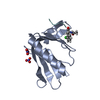 5n91C  5n9cSC 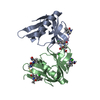 5n9pC  5najC  5nbfC 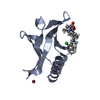 5nbxC  5nc2C  5ncfC  5ncgC  5ncpC  5nd0C  5nduC  5negC  6rcfC  6rcjC  6rd2C 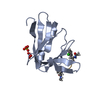 6xvtC  6xxrC  7a5mC  7akiC S: Starting model for refinement C: citing same article ( |
|---|---|
| Similar structure data |
- Links
Links
- Assembly
Assembly
| Deposited unit | 
| ||||||||
|---|---|---|---|---|---|---|---|---|---|
| 1 | 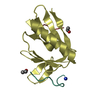
| ||||||||
| 2 | 
| ||||||||
| 3 | 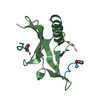
| ||||||||
| 4 | 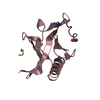
| ||||||||
| Unit cell |
|
- Components
Components
| #1: Protein | Mass: 12628.273 Da / Num. of mol.: 4 Source method: isolated from a genetically manipulated source Details: S2A, L68A, and R84A are mutated for modelling as only the backbone was visible Source: (gene. exp.)  Homo sapiens (human) / Gene: ENAH, MENA / Plasmid: pGEX-4T-1 Homo sapiens (human) / Gene: ENAH, MENA / Plasmid: pGEX-4T-1Production host:  References: UniProt: Q8N8S7 #2: Protein/peptide | Mass: 1204.307 Da / Num. of mol.: 8 / Source method: obtained synthetically Details: Termini not resolved in electrostatic binding site (chains W-Z) Source: (synth.)  Listeria monocytogenes (bacteria) / References: UniProt: P33379*PLUS Listeria monocytogenes (bacteria) / References: UniProt: P33379*PLUS#3: Water | ChemComp-HOH / | Has protein modification | Y | |
|---|
-Experimental details
-Experiment
| Experiment | Method:  X-RAY DIFFRACTION / Number of used crystals: 1 X-RAY DIFFRACTION / Number of used crystals: 1 |
|---|
- Sample preparation
Sample preparation
| Crystal | Density Matthews: 3.53 Å3/Da / Density % sol: 65.2 % |
|---|---|
| Crystal grow | Temperature: 293.15 K / Method: vapor diffusion, sitting drop / pH: 7 Details: Merged data set of crystals grown in 2.2M ammonium sulfate, 200mM lithium chloride and 2.2M ammonium sulfate, 200mM sodium nitrate Temp details: plate hotel |
-Data collection
| Diffraction | Mean temperature: 100 K | |||||||||
|---|---|---|---|---|---|---|---|---|---|---|
| Diffraction source | Source:  SYNCHROTRON / Site: SYNCHROTRON / Site:  BESSY BESSY  / Beamline: 14.1 / Wavelength: 0.918410, 0.918409 / Beamline: 14.1 / Wavelength: 0.918410, 0.918409 | |||||||||
| Detector | Type: DECTRIS PILATUS 6M / Detector: PIXEL / Date: Oct 23, 2013 | |||||||||
| Radiation | Protocol: SINGLE WAVELENGTH / Monochromatic (M) / Laue (L): M / Scattering type: x-ray | |||||||||
| Radiation wavelength |
| |||||||||
| Reflection | Resolution: 2.7→48.3445 Å / Num. obs: 20211 / % possible obs: 99.9 % / Redundancy: 5.3 % / CC1/2: 0.989 / Rrim(I) all: 0.23 / Net I/σ(I): 8.6 | |||||||||
| Reflection shell | Resolution: 2.7→2.8 Å / Redundancy: 5.3 % / Mean I/σ(I) obs: 1.53 / Num. unique obs: 2039 / CC1/2: 0.587 / Rrim(I) all: 1.534 / % possible all: 100 |
- Processing
Processing
| Software |
| |||||||||||||||||||||||||||||||||||||||||||||||||||||||||||||||||||||||||||||||||||||||||||||||||||||||||||||||||||||||||||||
|---|---|---|---|---|---|---|---|---|---|---|---|---|---|---|---|---|---|---|---|---|---|---|---|---|---|---|---|---|---|---|---|---|---|---|---|---|---|---|---|---|---|---|---|---|---|---|---|---|---|---|---|---|---|---|---|---|---|---|---|---|---|---|---|---|---|---|---|---|---|---|---|---|---|---|---|---|---|---|---|---|---|---|---|---|---|---|---|---|---|---|---|---|---|---|---|---|---|---|---|---|---|---|---|---|---|---|---|---|---|---|---|---|---|---|---|---|---|---|---|---|---|---|---|---|---|---|
| Refinement | Method to determine structure:  MOLECULAR REPLACEMENT MOLECULAR REPLACEMENTStarting model: 5N9C Resolution: 2.7→48.337 Å / SU ML: 0.44 / Cross valid method: FREE R-VALUE / σ(F): 1.35 / Phase error: 27.7
| |||||||||||||||||||||||||||||||||||||||||||||||||||||||||||||||||||||||||||||||||||||||||||||||||||||||||||||||||||||||||||||
| Solvent computation | Shrinkage radii: 0.9 Å / VDW probe radii: 1.11 Å | |||||||||||||||||||||||||||||||||||||||||||||||||||||||||||||||||||||||||||||||||||||||||||||||||||||||||||||||||||||||||||||
| Refinement step | Cycle: LAST / Resolution: 2.7→48.337 Å
| |||||||||||||||||||||||||||||||||||||||||||||||||||||||||||||||||||||||||||||||||||||||||||||||||||||||||||||||||||||||||||||
| Refine LS restraints |
| |||||||||||||||||||||||||||||||||||||||||||||||||||||||||||||||||||||||||||||||||||||||||||||||||||||||||||||||||||||||||||||
| LS refinement shell |
| |||||||||||||||||||||||||||||||||||||||||||||||||||||||||||||||||||||||||||||||||||||||||||||||||||||||||||||||||||||||||||||
| Refinement TLS params. | Method: refined / Refine-ID: X-RAY DIFFRACTION
| |||||||||||||||||||||||||||||||||||||||||||||||||||||||||||||||||||||||||||||||||||||||||||||||||||||||||||||||||||||||||||||
| Refinement TLS group |
|
 Movie
Movie Controller
Controller




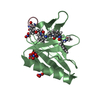
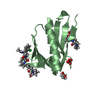
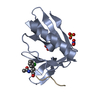
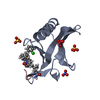
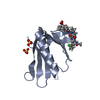
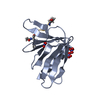

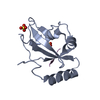

 PDBj
PDBj






